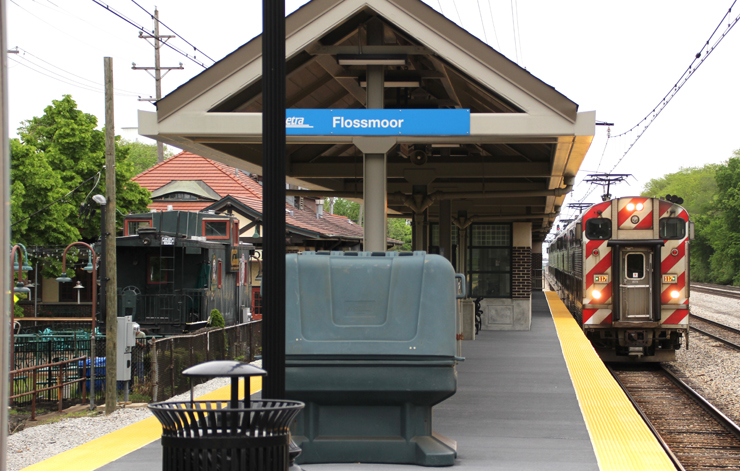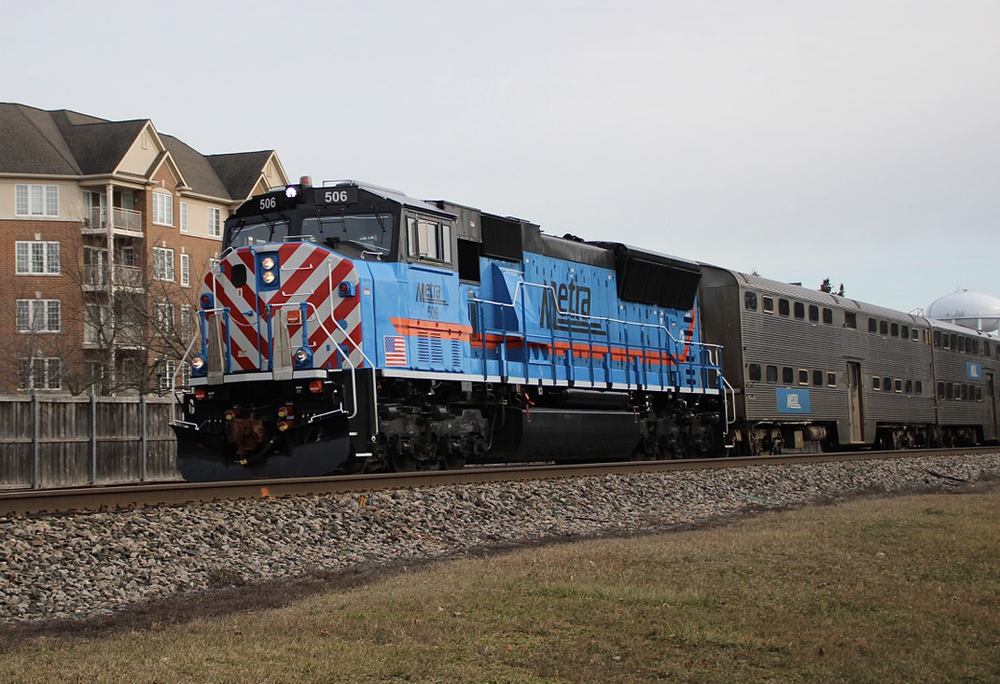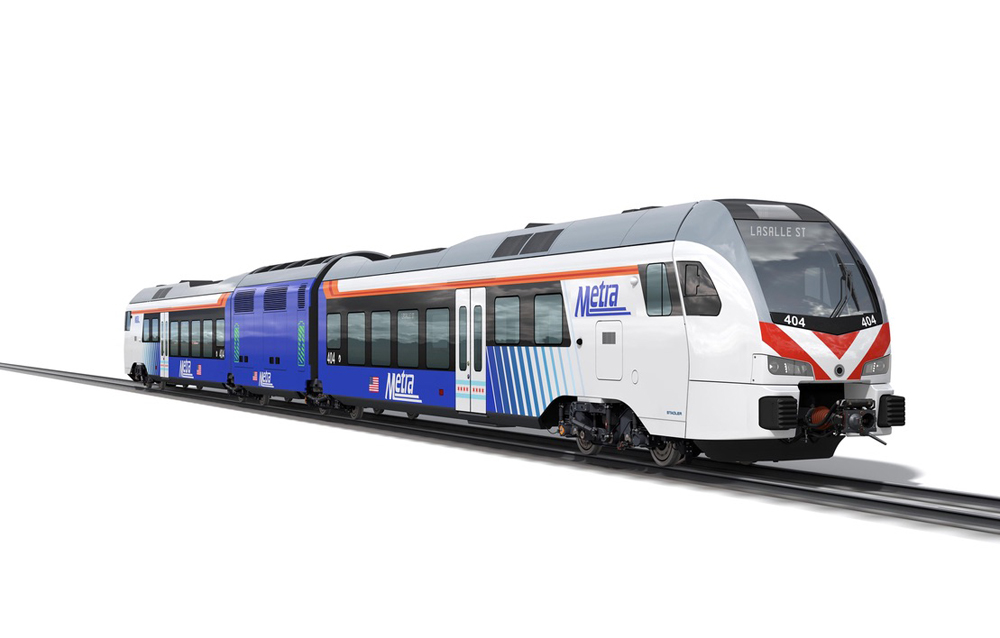
CHICAGO — Jim Derwinski hates the phrase “that’s the way we’ve always done it.”
At a Wednesday presentation for Northwestern University’s Sandhouse Rail Group, Derwinski, Metra’s CEO/Executive Director, illustrated why that’s the case, and the potential that comes from putting that approach in the past.

“Here’s a little story about where we’re not going to say that any more,” Derwinski told the Sandhouse meeting, which also featured Northern Indiana Commuter Transportation District (South Shore Line) President and General Manager Mike Noland. He then spelled out a project called “MED 90” — which seeks to bring operating speeds up to 90 mph on parts of the Metra Electric District.
“We operate at 65 miles an hour (on the Metra Electric) … and for the longest time, I’ve been saying, well, why are we running 65?” Derwinski said. It’s a reasonable question: The route is fully elevated and grade-crossing separated (save for one private crossing). It has no rail crossings at grade.
“Everybody said, well, it’s the signal system. But nobody’s got any data, and I’m a data-driven person. So I put a team together, and [Chief Mechanical Officer] Kevin McCann really led this. Once I put the challenge in front of them, they put a multidimensional team together, and said, ‘Let’s figure out how to actually get the best benefit out of that railroad.’”
And so, after extensive preparation, last Oct. 29, the project team operated an Electric District train at 79 mph. The railroad handled it just fine. Turns out, Derwinski said, that the 65-mph speed limit was based not on signal limitations, but braking algorithms from 1926, for Pullman-built cars two generations removed from the current Electric District equipment. Work is now underway to increase speeds in sections, from the end of the line working in: University Park to Homewood; Homewood to Kensington; Kensington to 67th Street; and 67th Street to McCormack Place.
“There are some physical infrastructure improvements that are going to get done,” Derwinski said. “The catenary system needs some upgrades; those parts are on order. The signal system, there are some places where we’re going to change slightly. … We believe we can get this to 79 (mph) and eventually, in certain sections, should be able to get to 90. And that’s going to be fantastic. …. You’re going to be able to get people to their destination in a much quicker amount of time.” Those shorter travel times will also allow for increased frequencies, which means the line gains capacity.
“This is just the first phase of figuring out how to not just do the things the way we’ve always done them,” Derwinski said.
SD70MACH update

Derwinski also spoke briefly about early impressions of the agency’s SD7OMACH locomotives, the remanufactured freight units that are now operating on the Milwaukee North, Milwaukee West, and North Central lines.
“They had a slow start,” he said. “We did have some technical issues with software. Thirteen of the 15 are up and running; talking to the engineers, talking to the crews, they’re running really great.”
The units are, as he termed it, “a reinvention. It’s taking a freight locomotive — and there are gobs of them out there available — and converting them to passenger service.” The locomotives, Metra’s first with AC power and first three-axle units since the retirement of 15 F40Cs, last used in 2012. These use one of the AC inverters to run the train’s head-end power, one reason they have just four powered axles (in a B1-1B configuration; see “Metra SD70MACHs begin revenue service,” Trains News Wire, Nov. 30, 2023). The locomotives have experienced “no delays to date,” Derwinski said.
The Metra CEO also recalled an early run with one of the SD70s on a Sunday congressional special between O’Hare Airport and downtown Chicago, one that saw the train turned so that the locomotive led the consist into town — the reverse of the normal operating conditions [see “News photos: Metra operates congressional special,” News Wire, Dec. 10, 2023]. The combination of the new locomotive and unusual operating setup brought out quite a few photographers, which did not go unnoticed.
“On the way back, we had the congressman up the cab,” Derwinski said. “That’s a nice sound-isolated cab, very quiet inside there, and you can fit a lot of people in that cab. So we had a good conversation as we’re going down the railroad, showing different elements that we’d like to improve on, and Congressman [Mike] Quigley says to me, ‘Well, what are all these people doing out here taking pictures?’
“I said, well, it’s obvious that they’re here for you.”
Battery trains on the way
Derwinski also provided a bit more information on Metra’s purchase of battery-electric trainsets, announced last week [see “Metra signs deal with Stadler US …,” News Wire, Feb. 21, 2024].

“This is newer technology,” Derwinski said, “but [Stadler’s] also, in Europe, got three other projects going where they’re already working on batteries. I’m very excited and pleased that Metra’s going to be the first commuter agency in the country to be running a trainset on all battery [power].”
Work is beginning on planning for charging and other infrastructure improvements necessary to support the equipment, Derwinski said, and reaffirmed that initial plans call for their use on the Rock Island District, “and from there we’ll see where they’re going to go.” He said he has high hopes for the equipment, but thinks the first big step is just to get them onto the system and see what they can do.
“You might look at those trainsets and say, you’re never going to fit a thousand people on there, and you’re right,” he said. “The idea is to get them up here. Let’s put them into minus-10 degrees … let’s figure out this battery technology and let’s get this to the point where in the future, at some point in time people say, well, that’s the way we’ve always done it.”














I think Mr. Derwinski is my new hero.
Not a fan of the that’s-how-we’ve-always-done-it canard. That said, increasing speeds increases energy consumption exponentially, not linearly. It also increases wear on rolling stock, track and, in this case, catenary. I’m hoping we’re not increasing speeds just for the sake of increasing speeds.
Higher speeds will draw more customers so more revenue. Could be a net win for Metra. Many commuter trains in Europe run faster than here. We should at least try it.
There’s a lot to like about Metra Electric. The ride is exceptionally smooth and the rolling stock is very attractive. Rebuilt stations up and down the line are a huge improvement over the old IC, which was dilapidated. And obviously Millenium and Van Buren Stations are far more convenient to parts of downtown which are remote from other Metra downtown terminals.
What I can’t stand about Metra Electric is Millenium Station. It’s a rebuild of the former IC Randolph Street hole in the ground. Access into the station from the city is every bit as bad as Randolph Street, which is to say, as bad as can be. Why rebuild the underground station if you can’t comfortably get in and out of it?
I love the look of those SD70MACH’s. I am also impressed with Jim Derwinski.
“Turns out, Derwinski said, that the 65-mph speed limit was based not on signal limitations, but braking algorithms from 1926, for Pullman-built cars two generations removed from the current Electric District equipment.”
It makes you wonder how much of the American railroad network is run on obsolete rules.
#sohappytoliveinillinois
I am impressed with this fellow, Mr. Derwinski.